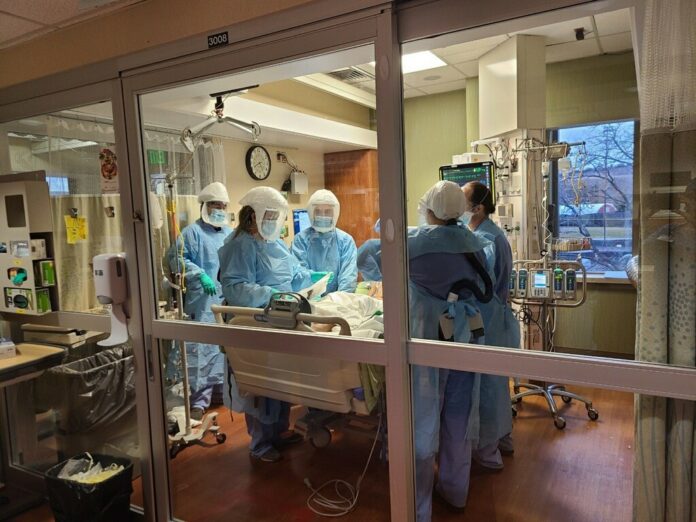
By Eric Valentine

If you have “COVID fatigue,” you’re probably not going to like what’s to follow. Yet, with America seeing more deaths due to COVID in one day compared to the terrorist attacks of 9/11, and with Idaho having one of the highest case rates (per 100,000 people) in the nation, you may want to stay abreast of the latest information anyway.
What follows is a rundown of three coronavirus-related matters: Drugs (specifically the vaccine); Daycare (specifically schools); and Death (specifically in Blaine County).
Drugs
Now that COVID-19 vaccines have garnered emergency FDA approval, St. Luke’s Health System says it’s ready to distribute them, which Pfizer delivered Tuesday morning in the form of 195 vials containing 975 doses.
Idaho’s Interim COVID-19 Vaccination Plan includes a three-phased approach, based on assumptions about vaccines likely to be approved for use in certain occupational groups and Idahoans in specific demographic categories, such as healthcare workers with high risk for exposure to SARS-CoV-2, older or immunocompromised Idahoans, and so on.
“Vaccines could be administered to the first St. Luke’s frontline healthcare workers as early as the end of the week,” St. Luke’s said.
The Pfizer vaccine will be shipped in a specially designed, temperature-controlled thermal shippers that use dry ice to maintain the recommended storage temperature conditions of -70 degrees for up to 10 days unopened. The packages are equipped with GPS-enabled thermal sensors to track the location and temperature of all shipments. Once the Pfizer vaccine is received at St. Luke’s, it will be handled with special leather gloves and stored in ultra-low-temperature freezers, which St. Luke’s purchased with the help of donations made by the community to the St. Luke’s COVID-19 Relief Fund. Those freezers are in place and ready, the hospital said. St. Luke’s also has an additional backup system that relies on dry ice. It’s anticipated the Moderna vaccine and supplies will also arrive at St. Luke’s within a few weeks to assist increasing access to those determined to receive the vaccine through Idaho’s approved rollout plan. The number of doses distributed to each organization will be determined by the state and local health districts.
Daycare
Amid the most abnormal school year in the district’s history, Blaine County School District trustees have decided that so-called hybrid learning will be the norm until at least February. They also plan to give three weeks’ notice before implementing any alternative format. BCSD began the school year in the hybrid plan wherein half of all students attend school in person on Mondays and Wednesdays and the other half on Tuesdays and Thursdays. That’s been the case districtwide except for Alturas Elementary and Silver Creek High School. Both schools had to go to 100 percent remote learning due to staff quarantining at different times this school year.
According to the school district, there are 13 active COVID cases amongst students and two amongst staff. That triggered 126 student quarantines due to risk of exposure and 16 staff quarantines due to risk of exposure. BCSD’s statistics are typically one week behind real-time data.
Death
The good news is—so long as you’re not one of the deceased or one of their loved ones—there have only been nine COVID-related deaths in Blaine County, as of press deadline Tuesday. The bad news is, the low mortality number could embolden some folks to gather in groups without regard to distancing and mask wearing. And that would mean an uptick in cases, which leads to an uptick in hospitalizations, which leads to healthcare infrastructure implosion, not to mention extended and/or expanded lockdown measures, which can lead to illness and injury that has nothing to do with COVID-19 at all.
The World Health Organization (WHO) has advised governments that before reopening, rates of positivity in testing should be 5 percent or lower for at least 14 days. The bad news is, in the 14-day period ending Dec. 12, Blaine County had a positivity rate of 13 percent. The good news is, on Nov. 30, that rate was at 20 percent, which means it’s going down. Or, it means the Thanksgiving-gathering-related uptick some folks are worried about hasn’t really hit yet.
WHO says if a positivity rate is too high, that may indicate the state is only testing the sickest patients who seek medical attention, and is not casting a wide enough net to know how much of the virus—which can be spread asymptomatically—is spreading within its communities. A low rate of positivity in testing data can be seen as a sign that a state has sufficient testing capacity for the size of their outbreak and is testing enough of its population to make informed decisions about reopening.


